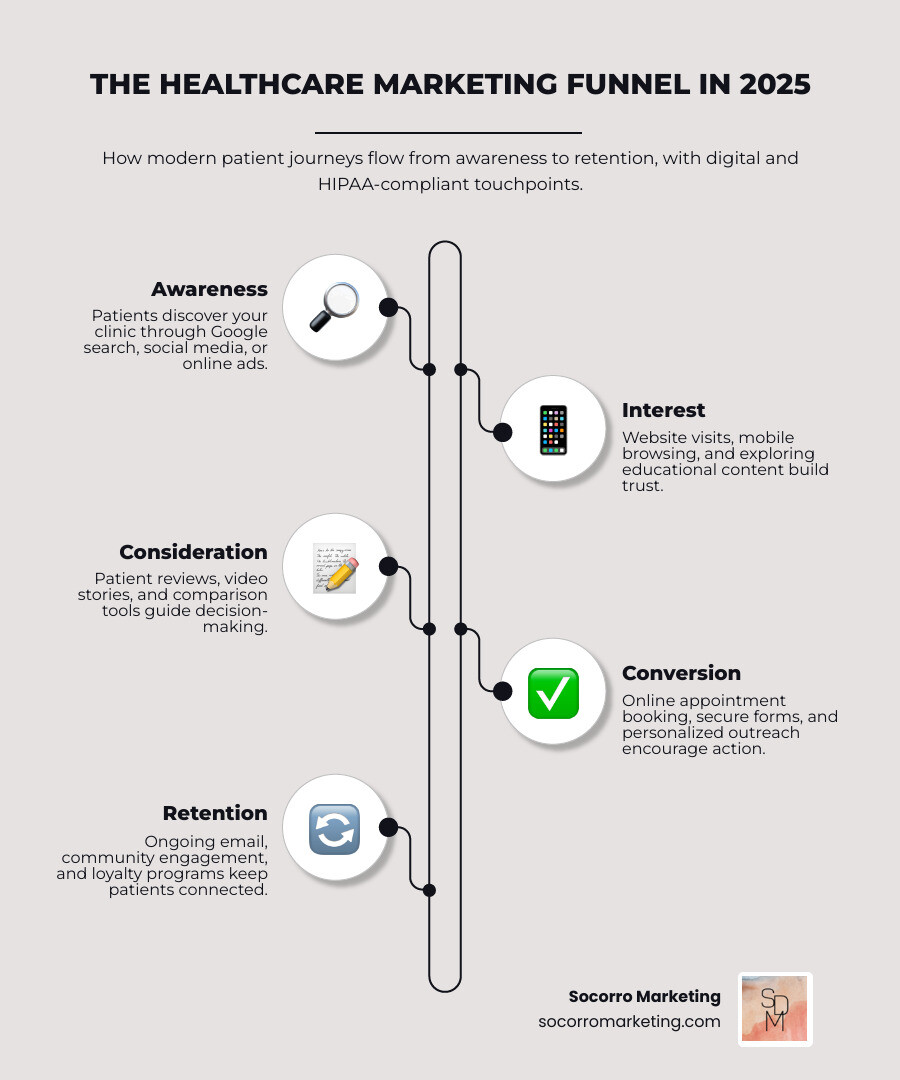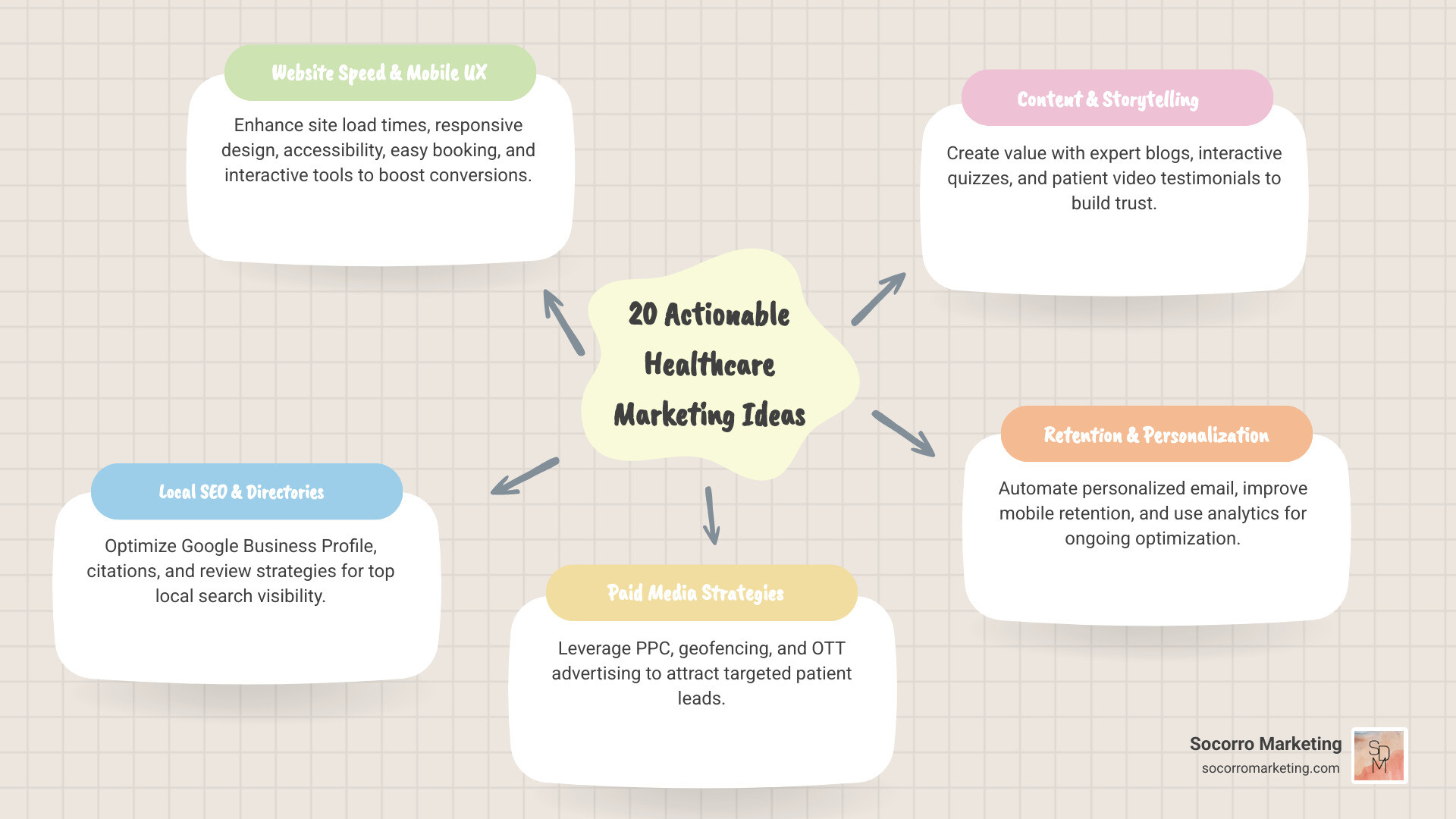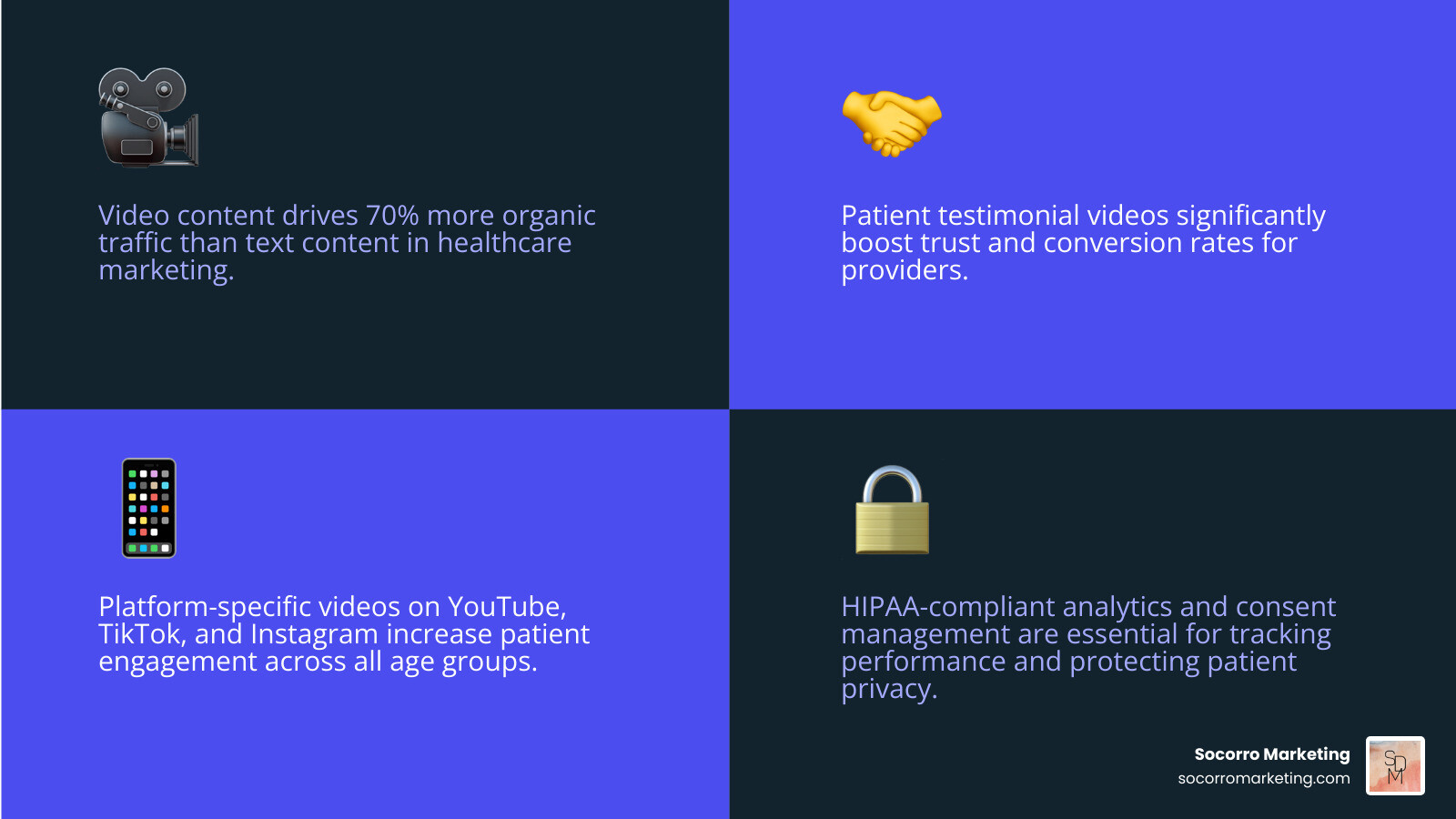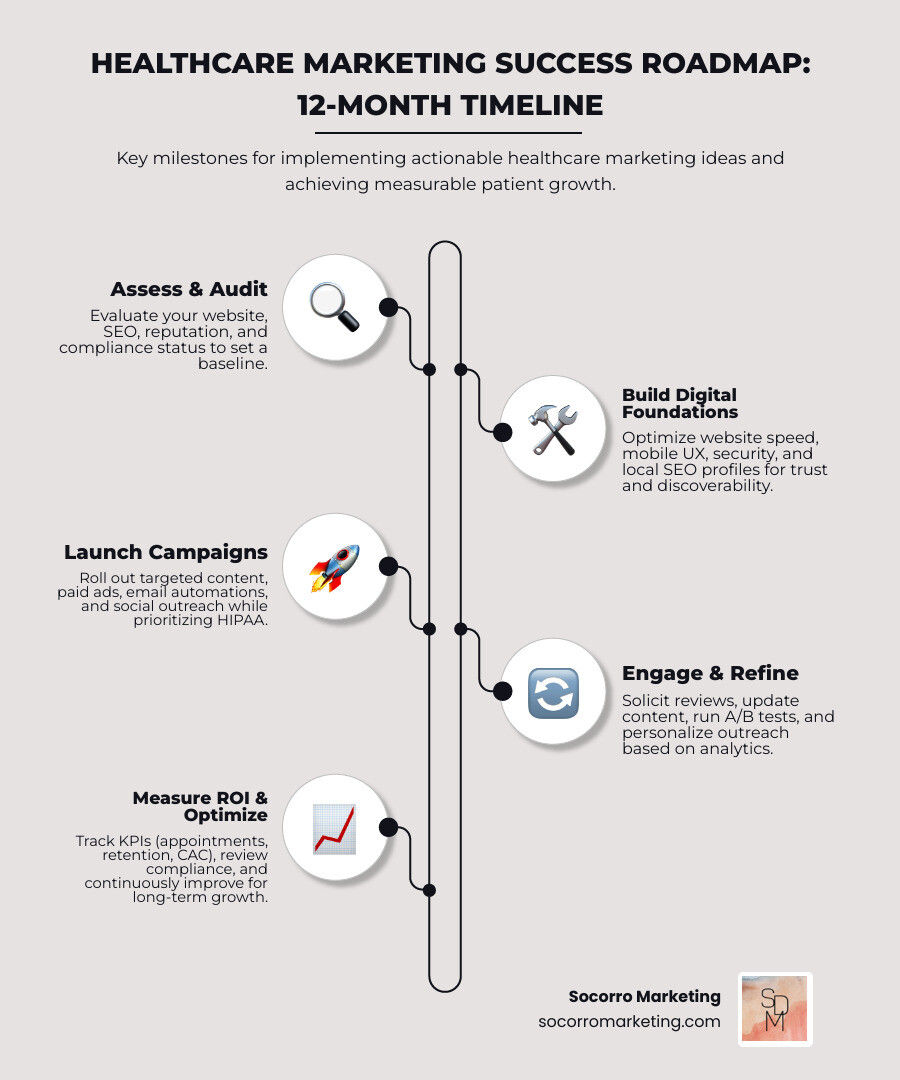Healthcare marketing ideas have become critical for medical practices as patient behavior shifts toward digital-first experiences. With over 1 billion health-related searches happening on Google daily, patients now research providers, compare services, and book appointments online before ever stepping into your clinic.
Top Healthcare Marketing Ideas for 2025:
The healthcare marketing landscape has evolved far beyond traditional advertising. Today's successful practices use data-driven strategies that educate patients, build trust, and create personalized experiences throughout the patient journey. The key is implementing marketing tactics that resonate with medical audiences while maintaining HIPAA compliance and clinical credibility.
As Grace Ascione, a registered nurse with an MBA and 15+ years of healthcare marketing experience, I've helped countless small healthcare businesses adapt to the digital landscape and implement effective healthcare marketing ideas that drive real patient growth. My clinical background combined with Google Analytics and SEO certifications allows me to bridge the gap between medical expertise and marketing strategy.

The healthcare marketing landscape in 2025 is defined by personalization, mobile-first experiences, and omnichannel patient engagement. With 80% of consumers demanding personalized brand experiences and over 50% of email campaigns viewed on mobile devices, healthcare practices must adapt their strategies to meet evolving patient expectations.
Our research shows that successful healthcare marketing combines clinical expertise with data-driven insights. We've identified 20 actionable healthcare marketing ideas that can transform your practice's patient acquisition and retention efforts.
Your website serves as your practice's digital front door, and first impressions matter. Google's mobile-first indexing means your site's mobile performance directly impacts search rankings and patient acquisition.
1. Optimize Page Load Speed
Site speed is crucial - consumers abandon websites after just 5 seconds of slow loading. Use Google PageSpeed Insights to identify and fix performance issues. Compress images, minimize code, and leverage browser caching to achieve sub-3-second load times.
2. Implement Mobile-Responsive Design
With mobile traffic dominating healthcare searches, responsive design isn't optional. Ensure your appointment booking forms, contact information, and service pages display perfectly on all devices. Test your site across different screen sizes and operating systems.
3. Improve Accessibility Features
Make your website accessible to patients with disabilities by implementing proper heading structures, alt text for images, and keyboard navigation. This not only improves user experience but also expands your potential patient base.
4. Streamline Conversion Paths
Simplify the patient journey from landing page to appointment booking. Place clear calls-to-action above the fold, minimize form fields, and offer multiple contact methods including phone, email, and online scheduling.
5. Add Interactive Elements
Incorporate symptom checkers, appointment schedulers, and patient portals to engage visitors and provide immediate value. These tools help patients self-serve while capturing valuable lead information.

Local SEO is fundamental for healthcare practices, as patients typically won't travel more than 15-20 miles for routine appointments. Dominating local search results can significantly impact patient acquisition.
6. Optimize Google Business Profile
Claim and fully optimize your Google Business Profile with complete information, high-quality photos, and regular posts. Use location keywords in your description's first sentence and maintain consistent NAP (Name, Address, Phone) information across all platforms.
7. Build Citation Authority
List your practice on key healthcare directories including Vitals, Healthgrades, WebMD, and Zocdoc. Ensure consistent information across all listings to build trust with both patients and search engines.
8. Target the Google 3-Pack
Focus on appearing in the local 3-pack results that appear above organic listings. This requires strong local SEO signals including reviews, citations, and location-specific content optimization.
9. Create Location-Specific Content
Develop blog posts and service pages targeting local keywords like "pediatrician in Golden CO" or "urgent care near me." Include local landmarks, community events, and area-specific health concerns in your content.
10. Manage Online Reviews Strategically
Since 98% of consumers see reviews as essential for decision-making, implement a systematic review collection process. Ask satisfied patients for reviews immediately after appointments and respond professionally to all feedback.
Scientific research on local search visibility shows that businesses appearing in the local 3-pack receive 44% of clicks for local searches.
Paid advertising allows healthcare practices to reach specific patient demographics with targeted messaging. Modern paid media strategies go beyond traditional search ads to include innovative approaches like geofencing and streaming TV.
11. Launch Targeted PPC Campaigns
Create search campaigns targeting specific treatments and conditions. Use ad extensions to highlight credentials, location, and unique services. Focus on "pull" marketing by targeting patients actively searching for healthcare solutions.
12. Implement Geofencing Strategies
Set up geofencing campaigns around relevant locations like gyms, pharmacies, or competitor practices. This allows you to reach potential patients when they're in locations indicating health-related intent.
13. Explore OTT and Connected TV Advertising
Leverage over-the-top (OTT) and connected TV (CTV) platforms to deliver video ads to local audiences. These platforms offer cost-effective alternatives to traditional TV advertising with better targeting and measurement capabilities.
14. Develop Retargeting Campaigns
Create remarketing campaigns to re-engage website visitors who didn't convert. Segment audiences based on pages visited and customize messaging to address specific interests or concerns.
15. Test Interactive Ad Formats
Experiment with interactive ad formats like polls, quizzes, and video ads that encourage engagement. These formats can improve click-through rates and provide valuable patient insights.
More info about PPC services can help you optimize your paid advertising campaigns for better ROI.
Email marketing remains one of the most effective channels for patient retention and engagement. With proper segmentation and automation, email campaigns can nurture patient relationships and drive appointment bookings.
16. Segment Email Lists by Patient Type
Create targeted email segments based on patient demographics, conditions, and appointment history. This allows for personalized messaging that resonates with specific patient groups.
17. Automate Appointment Reminders
Set up automated email sequences for appointment reminders, follow-up care instructions, and preventive care notifications. This reduces no-shows and improves patient compliance.
18. Create Educational Newsletter Series
Develop monthly newsletters featuring health tips, seasonal wellness advice, and practice updates. Focus on providing value rather than promotional content to build trust and engagement.
19. Implement Mobile-Optimized Templates
Since over 50% of email campaigns are viewed on mobile devices, ensure your email templates are mobile-responsive with clear calls-to-action and readable fonts.
20. Track Email Performance Metrics
Monitor open rates, click-through rates, and conversion metrics to optimize email performance. A/B test subject lines, send times, and content formats to improve engagement.
More info about email marketing provides detailed strategies for healthcare email campaigns.
Creating a trustworthy digital presence requires more than just an attractive website. Patients need to feel confident in your practice's credibility, security, and expertise before booking appointments.
Technical Foundation Elements:
Google's Core Web Vitals have become critical ranking factors, measuring loading performance, interactivity, and visual stability. Healthcare websites must excel in these areas to maintain search visibility and patient trust.
Security Considerations:
Implement robust security measures including SSL certificates, secure hosting, and regular security updates. Display trust badges and security certifications prominently to reassure patients about data protection.
More info about SEO strategy can help you build a strong technical foundation for your healthcare website.
Structured Data Implementation:
Add healthcare-specific schema markup to help search engines understand your content. Include organization details, service offerings, physician credentials, and patient reviews in structured format.
Voice Search Optimization:
With the rise of voice assistants, optimize for conversational queries like "What are the symptoms of strep throat?" or "Find a pediatrician near me." Create FAQ pages that directly answer common patient questions.
Local Snippet Optimization:
Structure your content to appear in featured snippets and local search results. Use clear headings, bullet points, and concise answers to common healthcare questions.
Privacy-First Analytics:
Implement Google Analytics 4 with proper privacy controls and consent management. Use aggregate data to understand patient behavior without compromising individual privacy.
Call Tracking Solutions:
Deploy HIPAA-compliant call tracking to measure phone conversions from marketing campaigns. This provides valuable insights into which marketing channels drive the most patient inquiries.
Consent Management:
Implement clear consent banners and privacy notices that explain data collection practices. Ensure all tracking pixels and analytics tools comply with HIPAA requirements.
Video content drives significantly better engagement than text-based content. Healthcare practices can leverage video to build trust, educate patients, and showcase expertise.
Platform-Specific Video Strategies:
Video Content Ideas:
Scientific research on video engagement shows that video content receives 70% more organic traffic than text-based content.

Content marketing serves as the foundation for building patient trust and demonstrating clinical expertise. Educational content helps patients make informed decisions while positioning your practice as a trusted authority.
Topic Cluster Strategy:
Develop comprehensive content hubs around key service areas. For example, create a diabetes management hub with articles covering symptoms, treatment options, lifestyle modifications, and prevention strategies.
Keyword Research for Healthcare:
Use tools like SEMrush's Keyword Magic Tool to identify high-volume, low-competition healthcare keywords. Focus on long-tail keywords that match patient search intent, such as "when to see a cardiologist for chest pain."
Expert Review Process:
Ensure all content undergoes clinical review by qualified healthcare professionals. This maintains accuracy and supports E-A-T (Expertise, Authoritativeness, Trustworthiness) signals that Google values for medical content.
Content Distribution Strategy:
More info about content marketing provides detailed strategies for healthcare content creation.
Interactive content engages patients while providing valuable lead generation opportunities. These tools help pre-qualify patients and demonstrate your practice's commitment to patient education.
Risk Assessment Tools:
Create interactive questionnaires for common conditions like diabetes risk, heart disease screening, or mental health assessments. These tools provide immediate value while capturing patient contact information.
Symptom Checkers:
Develop condition-specific symptom checkers that guide patients toward appropriate care. Include clear disclaimers about seeking professional medical advice for serious symptoms.
Health Calculators:
Implement calculators for BMI, pregnancy due dates, medication dosages, or treatment costs. These practical tools attract organic traffic and provide ongoing value to patients.
Authentic patient stories build trust and credibility more effectively than traditional advertising. However, healthcare practices must carefully manage testimonials to ensure HIPAA compliance.
Testimonial Collection Process:
Video Testimonial Best Practices:
Review Management Strategy:
Implement systematic review collection across platforms like Google, Yelp, and Healthgrades. Since 50% of consumers trust online reviews as much as personal recommendations, maintaining a strong review profile is essential.
Building strong community connections and personalizing patient experiences creates lasting relationships that drive referrals and retention. Modern healthcare marketing goes beyond advertising to create genuine community engagement.
Platform-Specific Strategies:
Content Calendar Planning:
Develop a monthly content calendar that includes:
Engagement Best Practices:
Respond promptly to comments and messages while maintaining HIPAA compliance. Use social media as a platform for health education rather than providing specific medical advice.
Community involvement builds trust and demonstrates your practice's commitment to public health. Preventive care campaigns can significantly impact community health outcomes while building brand awareness.
Health Fair Participation:
Participate in local health fairs to provide free screenings and health education. These events offer face-to-face interaction opportunities and help establish your practice as a community health resource.
Preventive Care Campaigns:
Develop campaigns around preventive care initiatives like flu vaccinations, cancer screenings, or diabetes prevention programs. The preventive healthcare market is projected to reach $415 billion by 2031, indicating strong patient interest in prevention.
Educational Workshops:
Host free workshops on topics like nutrition, exercise, or chronic disease management. These events provide value to the community while showcasing your expertise.
Scientific research on preventive campaigns demonstrates the effectiveness of community-based prevention programs in improving health outcomes.
Personalized healthcare marketing creates more meaningful patient connections and improves engagement rates. Use available data to tailor communications and recommendations to individual patient needs.
EHR Data Integration:
Leverage electronic health record data to create personalized patient communications. Send targeted reminders for preventive care, follow-up appointments, and health screenings based on individual patient profiles.
Segmentation Strategies:
Segment patients based on:
AI-Powered Recommendations:
Implement AI tools to provide personalized health recommendations and content suggestions. These systems can analyze patient data to suggest relevant educational content and preventive care measures.
SMS and Text Messaging:
Use SMS for appointment reminders, medication alerts, and health tips. Text messaging has high open rates and provides immediate communication with patients.
Successful healthcare marketing requires continuous measurement, optimization, and strict adherence to privacy regulations. Establishing clear metrics and compliance protocols ensures sustainable growth while protecting patient information.
Key Performance Indicators for Healthcare Marketing:
SMART Goal Examples:
A/B Testing Framework:
Implement systematic A/B testing for:
Multivariate Testing:
Test multiple variables simultaneously to identify optimal combinations. For example, test different combinations of headline, image, and call-to-action on appointment booking pages.
Performance Monitoring Tools:
HIPAA Compliance Requirements:
Privacy Notice Requirements:
Staff Training Programs:
Start by assessing your current digital presence and identifying gaps in patient acquisition channels. Focus on foundational elements first:
Small practices should prioritize healthcare marketing ideas that provide the highest ROI with limited resources. Local SEO and review management typically offer the best returns for smaller healthcare businesses.
Essential measurement tools include:
Analytics Platforms:
Healthcare-Specific Tools:
Key Metrics to Track:
HIPAA compliance requires careful planning and ongoing vigilance:
Before Implementation:
During Implementation:
Ongoing Compliance:
Implementing effective healthcare marketing ideas requires a strategic approach that balances patient needs with business objectives. The 20 actionable strategies we've outlined provide a comprehensive framework for building a successful healthcare marketing program in 2025.
Success in healthcare marketing comes from understanding that patients are consumers who research, compare, and choose healthcare providers based on digital experiences. By focusing on website optimization, local SEO, content marketing, and community engagement, healthcare practices can build trust and attract new patients while maintaining HIPAA compliance.
At Socorro Marketing, we understand the unique challenges healthcare practices face in implementing these strategies. Our nurse-managed approach combines clinical expertise with proven marketing techniques to deliver results that matter - more patients, better outcomes, and sustainable growth.
The key to success lies in starting with solid foundations - a fast, mobile-responsive website, optimized local search presence, and systematic review management. From there, you can expand into more advanced strategies like video marketing, personalization, and community outreach.
Healthcare marketing is a marathon, not a sprint. Consistent implementation of these healthcare marketing ideas will compound over time, creating a strong digital presence that attracts and retains patients for years to come.
Ready to transform your healthcare marketing strategy? More info about digital marketing services can help you implement these ideas with the clinical insight and marketing expertise your practice deserves.
